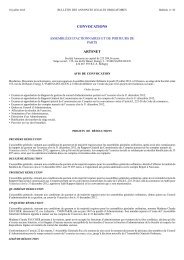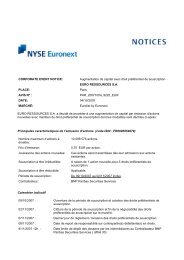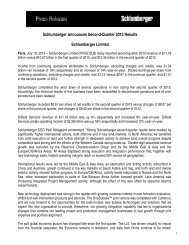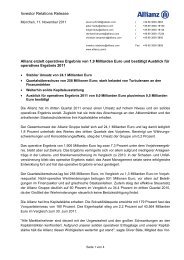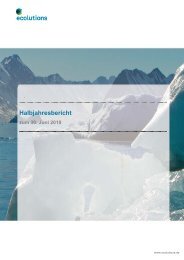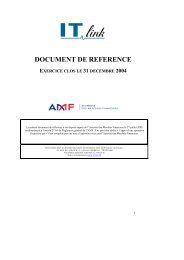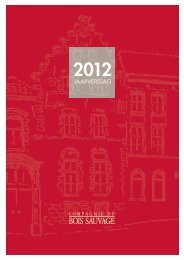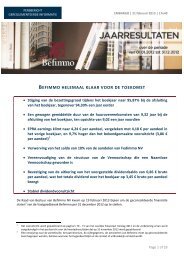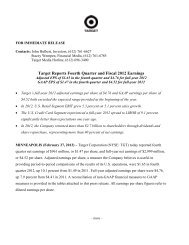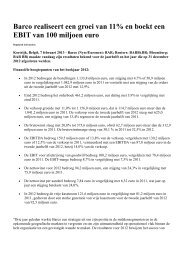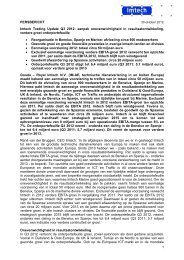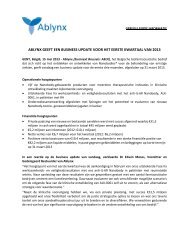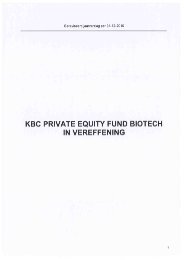Download full Annual Report and Accounts - Kingfisher
Download full Annual Report and Accounts - Kingfisher
Download full Annual Report and Accounts - Kingfisher
You also want an ePaper? Increase the reach of your titles
YUMPU automatically turns print PDFs into web optimized ePapers that Google loves.
Kingfi sher plc<br />
<strong>Annual</strong> <strong>Report</strong><br />
<strong>and</strong> <strong>Accounts</strong><br />
2009/10<br />
61<br />
The following amendments to st<strong>and</strong>ards <strong>and</strong> interpretation, which are m<strong>and</strong>atory for the fi rst time for the fi nancial year beginning 1 February 2009, are either not<br />
currently relevant or material for the Group:<br />
– IAS 39 (amendment), ‘Financial instruments: Recognition <strong>and</strong> measurement’;<br />
– IAS 39 <strong>and</strong> IFRS 7 (amendment), ‘Reclassifi cation of fi nancial assets’; <strong>and</strong><br />
– IFRIC 16, ‘Hedges of a net investment in a foreign operation’.<br />
At the date of authorisation of these fi nancial statements, the following new st<strong>and</strong>ard <strong>and</strong> amendments, which are expected to be relevant to the Group’s results,<br />
were issued but not yet effective:<br />
IAS 27<br />
(amendment)<br />
IFRS 3<br />
(amendment)<br />
Consolidated <strong>and</strong> separate fi nancial<br />
statements - Non-controlling interests<br />
(effective from 1 July 2009)<br />
Business combinations<br />
(effective from 1 July 2009)<br />
IFRS 9 Financial instruments<br />
(effective from 1 January 2013)<br />
The consolidated fi nancial statements have been prepared under the historical<br />
cost convention, as modifi ed by the use of valuations for certain fi nancial<br />
instruments, share-based payments <strong>and</strong> post employment benefi ts.<br />
A summary of the Group’s principal accounting policies is set out below.<br />
The preparation of fi nancial statements in conformity with IFRS requires<br />
the use of certain accounting estimates <strong>and</strong> assumptions. It also requires<br />
management to exercise its judgement in the process of applying the Group’s<br />
accounting policies. The areas involving critical accounting estimates <strong>and</strong><br />
judgements, which are signifi cant to the consolidated fi nancial statements,<br />
are disclosed in note 3.<br />
Use of non-GAAP measures<br />
Kingfi sher believes that retail profi t, adjusted pre-tax profi t, effective tax rate,<br />
adjusted post-tax profi t <strong>and</strong> adjusted earnings per share provide additional<br />
useful information on underlying trends to shareholders. These <strong>and</strong> other<br />
non-GAAP measures such as net debt are used by Kingfi sher for internal<br />
performance analysis <strong>and</strong> incentive compensation arrangements for<br />
employees. The terms ‘retail profi t’, ‘exceptional items’, ‘adjusted’, ‘effective<br />
tax rate’ <strong>and</strong> ‘net debt’ are not defi ned terms under IFRS <strong>and</strong> may therefore<br />
not be comparable with similarly titled measures reported by other companies.<br />
They are not intended to be a substitute for, or superior to, GAAP measures.<br />
Retail profi t is defi ned as continuing operating profi t before central costs<br />
(principally the costs of the Group’s head offi ce), exceptional items,<br />
amortisation of acquisition intangibles <strong>and</strong> the Group’s share of interest<br />
<strong>and</strong> tax of joint ventures <strong>and</strong> associates.<br />
The separate reporting of non-recurring exceptional items, which are<br />
presented as exceptional within their relevant income statement category,<br />
helps provide an indication of the Group’s underlying business performance.<br />
The principal items which are included as exceptional items are:<br />
– non trading items included in operating profi t such as profi ts <strong>and</strong> losses on<br />
the disposal, closure or impairment of subsidiaries, joint ventures, associates<br />
<strong>and</strong> investments which do not form part of the Group’s trading activities;<br />
– profi ts <strong>and</strong> losses on the disposal of properties; <strong>and</strong><br />
– the costs of signifi cant restructuring <strong>and</strong> incremental acquisition<br />
integration costs.<br />
Requires the effects of all transactions with non-controlling (minority) interests to be recorded in equity<br />
if there is no change in control. They will no longer result in goodwill or gains <strong>and</strong> losses. The<br />
amended st<strong>and</strong>ard also specifi es the accounting when control is lost. Any remaining interest in the<br />
entity is remeasured to fair value <strong>and</strong> a gain or loss is recognised in profi t or loss. This will be applied in<br />
the Group’s 2010/11 fi nancial statements.<br />
Harmonises business combination accounting with US GAAP. The amended st<strong>and</strong>ard will continue to<br />
apply the acquisitions method to business combinations, but with certain signifi cant changes. All<br />
payments to purchase a business will be recorded at fair value at the acquisition date, with some<br />
contingent payments subsequently remeasured at fair value through income. Goodwill <strong>and</strong> noncontrolling<br />
(minority) interests may be calculated on a gross or net basis. All transaction costs will be<br />
expensed. This will be applied in the Group’s 2010/11 fi nancial statements.<br />
Introduces new requirements for classifying <strong>and</strong> measuring fi nancial assets. This includes the removal of<br />
available-for-sale fi nancial assets <strong>and</strong> held-to-maturity investments, <strong>and</strong> the introduction of a new category<br />
of fi nancial assets at fair value through other comprehensive income. This is still subject to endorsement by<br />
the European Union, but is currently expected to be applied in the Group’s 2013/14 fi nancial statements.<br />
The term ‘adjusted’ refers to the relevant measure being reported for continuing<br />
operations excluding exceptional items, fi nancing fair value remeasurements,<br />
amortisation of acquisition intangibles, related tax items <strong>and</strong> prior year tax items.<br />
Financing fair value remeasurements represent changes in the fair value of<br />
fi nancing derivatives, excluding interest accruals, offset by fair value adjustments to<br />
the carrying amount of borrowings <strong>and</strong> other hedged items under fair value<br />
hedge relationships. Financing derivatives are those that relate to underlying<br />
items of a fi nancing nature.<br />
The effective tax rate represents the effective income tax expense as a<br />
percentage of continuing profi t before taxation excluding exceptional items.<br />
Effective income tax expense is the continuing income tax expense excluding tax<br />
on exceptional items <strong>and</strong> tax adjustments in respect of prior years <strong>and</strong> changes<br />
in tax rates.<br />
Net debt comprises borrowings <strong>and</strong> fi nancing derivatives (excluding accrued<br />
interest), less cash <strong>and</strong> cash equivalents <strong>and</strong> current other investments.<br />
b. Basis of consolidation<br />
The consolidated fi nancial statements incorporate the fi nancial statements<br />
of the Company, its subsidiaries, joint ventures <strong>and</strong> associates.<br />
(i) Subsidiaries<br />
Subsidiary undertakings are all entities over which the Group has the power<br />
to govern the fi nancial <strong>and</strong> operating policies, generally accompanying a<br />
shareholding of more than one half of the voting rights. Subsidiary undertakings<br />
acquired during the period are recorded under the acquisition method of<br />
accounting <strong>and</strong> their results included from the date of acquisition. The results of<br />
subsidiaries which have been disposed of during the period are included<br />
up to the effective date of disposal.<br />
The acquisition method of accounting is used to account for the acquisition<br />
of subsidiaries by the Group. The cost of an acquisition is measured as the<br />
fair value of the assets given, equity instruments issued <strong>and</strong> liabilities incurred<br />
or assumed at the date of exchange, plus costs directly attributable to the<br />
acquisition. Identifi able assets acquired <strong>and</strong> liabilities <strong>and</strong> contingent liabilities<br />
assumed in a business combination are measured initially at their fair values<br />
at the acquisition date, irrespective of the extent of any minority interest.<br />
The excess of the cost of acquisition over the fair value of the Group’s share



